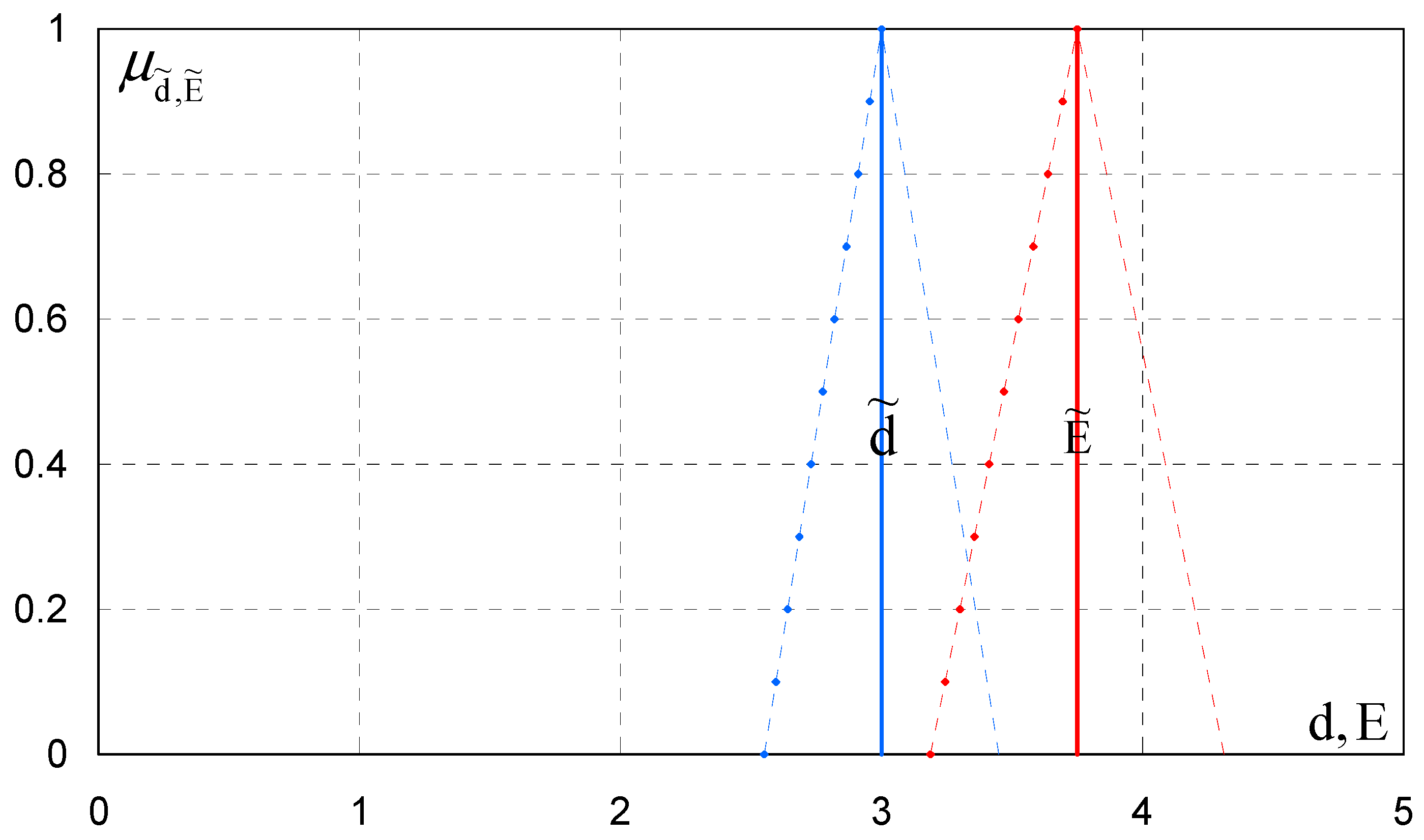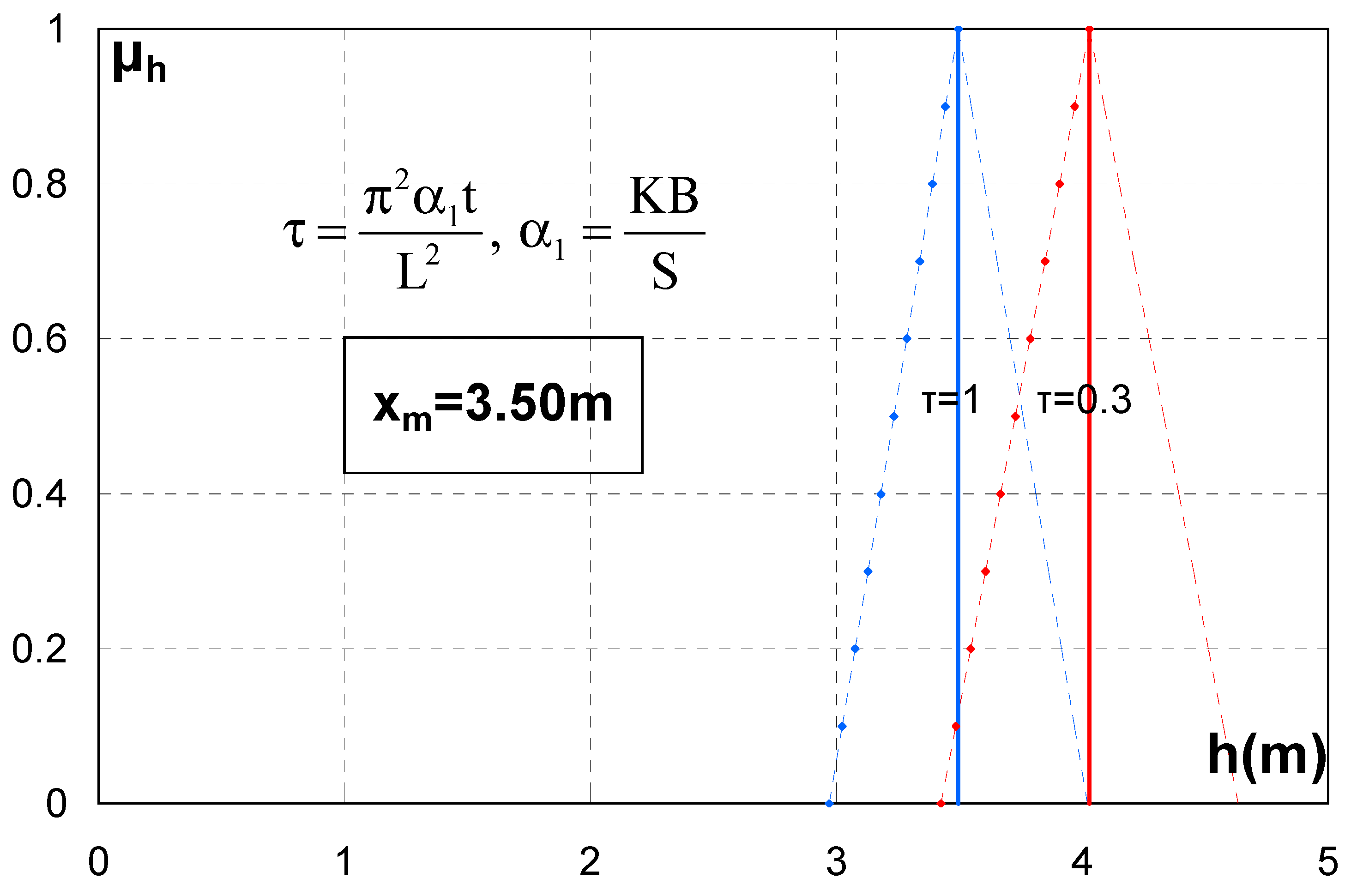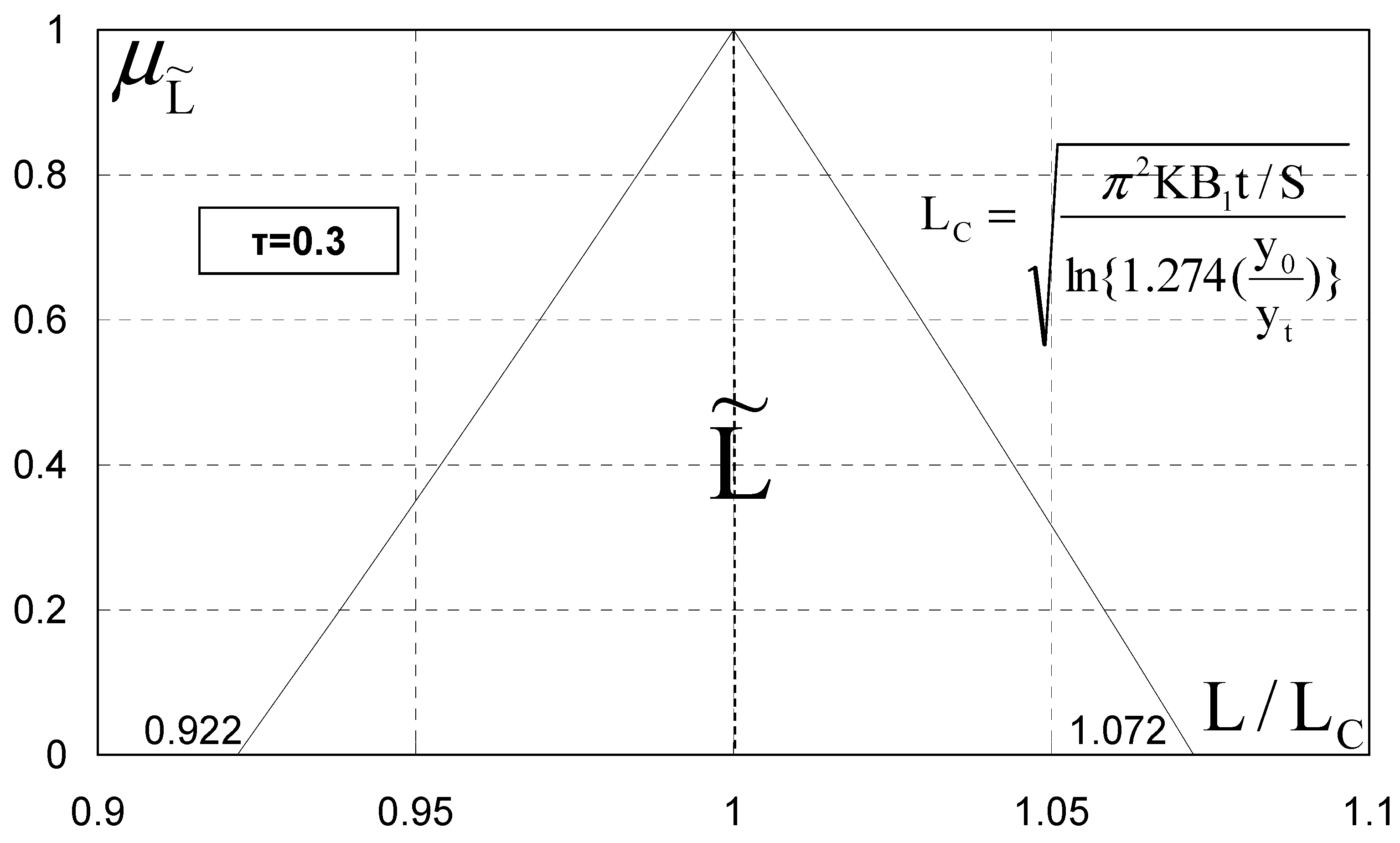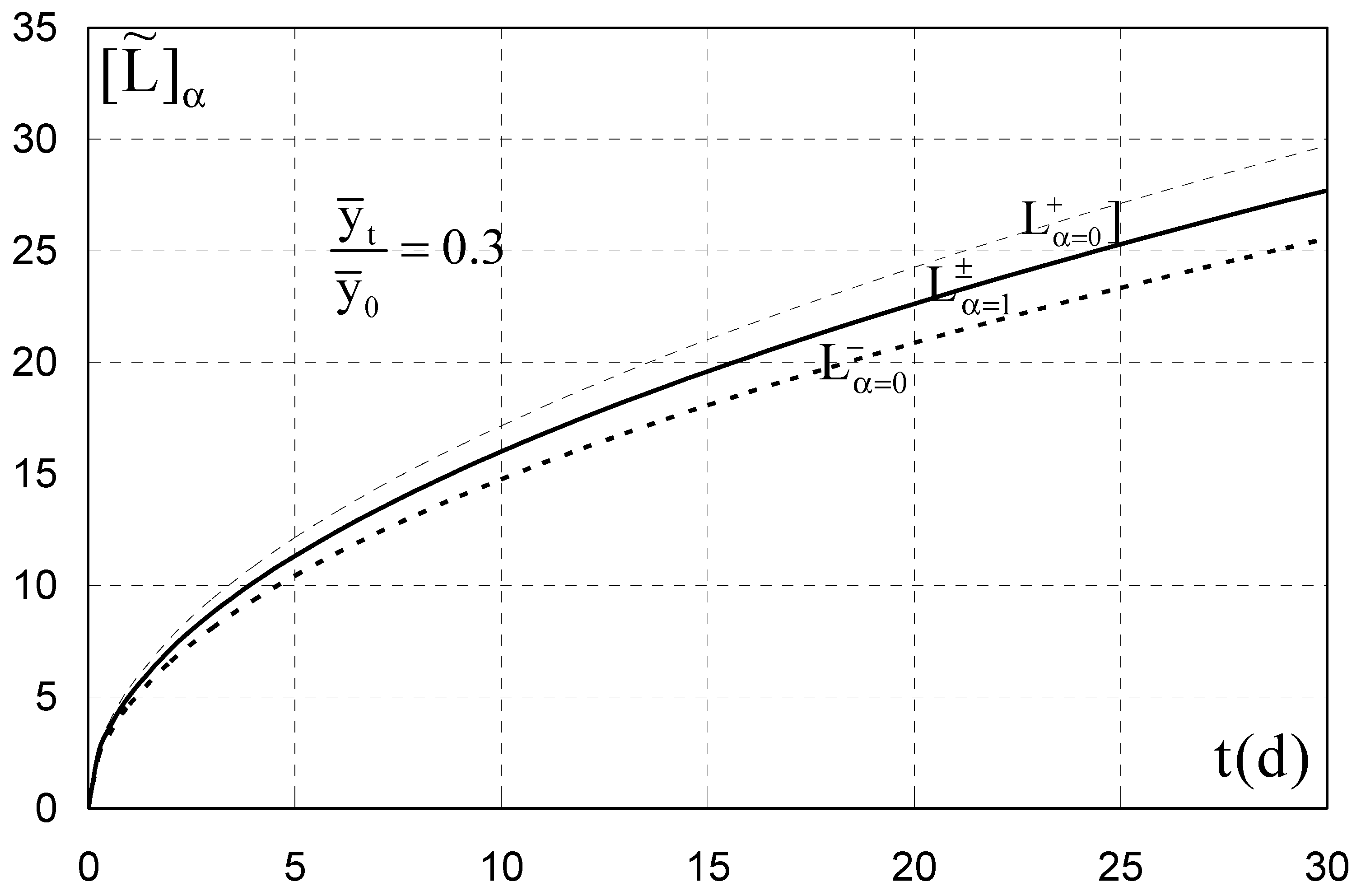Fuzzy Unsteady-State Drainage Solution for Land Reclamation
Abstract
:1. Introduction
2. Materials and Methods
2.1. Linearized Bousinesq Equation
2.1.1. Classical Case
2.1.2. Linearized Boussinesq Solution Based on the ADM
2.1.3. Drain Spacing
2.1.4. Fuzzy Case
3. Fuzzy Framework and Definitions
- 1.
- is increasing, is decreasing as functions of α, and, or
- 2.
- is increasing, is decreasing as functions of α, and
- is (i)-gH-differentiable at x0 if:
- is (ii)-gH-differentiable at x0 if:
- is [(i)-p]-differentiable w.r.t. x at (x0, t0) if:
- is [(ii)-p]-differentiable w.r.t. x at (x0, t0) if:
4. The Proposed Solution to the Fuzzy Model
4.1. Corresponding System
- First case
- Second case
4.2. The Adomian Solution
4.2.1. First Case
4.2.2. Second Case
4.3. Fuzzy Drain Spacing
5. Results—Application
6. Discussion and Future Research
7. Conclusions
Author Contributions
Funding
Data Availability Statement
Conflicts of Interest
Appendix A
References
- Ziccarelli, M.; Valore, C. Hydraulic conductivity and strength of pervious concrete for deep trench drains. Geomech. Energy Environ. 2018, 18, 41–55. [Google Scholar] [CrossRef]
- Qian, Y.; Zhu, Y.; Ye, M.; Huang, J.; Wu, J. Experiment and numerical simulation for designing layout parameters of subsurface drainage pipes in arid agricultural areas. Agric. Water Manag. 2021, 243, 106–455. [Google Scholar] [CrossRef]
- Karamouzis, D.; Zissis, T.; Terzidis, G. Non-dimensional Diagrams for Unsteady Drainage Problems with or Without recharge. Agric. Water Manag. 1988, 13, 145–156. [Google Scholar] [CrossRef]
- Hooghoudt, S.B. Bijdragen tot de Kennis van Enige Natuurkundige Grootheden van de Grond; Versl. Landbook Onderzoek; Algemeene Landsdrukkerij: The Hague, The Netherlands, 1940; Volume 46, pp. 515–707. [Google Scholar]
- Toksöz, S.; Kirkham, D. Steady Drainage of Layered Soils: II. Nomographs. J. Irrig. Drain. Div. 1971, 97, 1–37. [Google Scholar] [CrossRef]
- Ernst, L.F. Grondwaterstromingen in de Verzadigde Zone en Hun Berekening Bij Aanwezigheid van Horizontale Evenwijdige Open; Versl. Landbouwk. Onderz; Centrum voor Landbouwpublikaties en Landbouwdocumentatie: Wageningen, The Netherlands, 1962; Volume 76, p. 15. [Google Scholar]
- Terzides, G.; Karamouzis, D. Land Drainage; Ziti Ed.: Thessaloniki, Greece, 1986. (In Greek) [Google Scholar]
- Terzides, G. A simple and exact method for stratified drainage soils. In Proceedings of the 3rd National Conference EGME, Thessaloniki, Greece, October 2003. (In Greek). [Google Scholar]
- Tzimopoulos, C. Drainage Engineering-Well Hydrology; Ziti Ed.: Thessaloniki, Greece, 1982. (In Greek) [Google Scholar]
- Kirkham, D. Seepage of steady rainfall through soil into drains. Eos Trans. Am. Geophys. Union 1958, 39, 892–908. [Google Scholar] [CrossRef]
- Dagan, G. Steady Drainage of a Τwo-Layered Soil. J. Irrig. Drain. Div. 1965, 91, 51–64. [Google Scholar] [CrossRef]
- Van der Molen, W.H.; Wesseling, J. A solutiom in closed form and a series solution to replace the tables for the thickness of the equivalent layer in Hooghoudt’s drain spacing formula. Agric. Water Manag. 1991, 19, 1–16. [Google Scholar] [CrossRef]
- Ritzema, H.P. Subsurface Flow to Drains. In Drainage Principles and Applications; International Institute for Land Reclamation and Improvement: Wageningen, The Netherlands, 1994. [Google Scholar]
- Μishra, G.C.; Singh, V. A new drain spacing formula. Hydrol. Sci. J. 2007, 52, 338–351. [Google Scholar] [CrossRef] [Green Version]
- Afruzi, A.; Νazemi, A.H.; Sadraddini, A.A. Steady-state subsurface drainage of ponded fields by rectangular ditch drains. Irrig. Drain. 2014, 63, 668–681. [Google Scholar] [CrossRef]
- Dumm, L.D. Drain spacing formula. Agric. Eng. 1954, 35, 726–730. [Google Scholar]
- Dumm, L.D. Validity and use of the transient flow concept in subsurface drainage. In Proceedings of the ASAE Meeting, Memphis, TN, USA, 1 December 1960; pp. 4–7. [Google Scholar]
- Bureau of Reclamation. Drainage Manual; U.S. Department of the Interior: Washington, DC, USA, 1993.
- Tzimopoulos, C.; Terzidis, G. Écoulement non permanent dans un sol drainé par des fossés parallèles. J. Hydrol. 1975, 27, 73–93. [Google Scholar] [CrossRef]
- McDonald, M.G.; Harbaugh, A.W. A Modular Three-Dimensional Finite-Difference Ground-Water Flow Model; Techniques of Water-Resource Investigations of the United States Geological Survey, Book 6, Modeling Techniques; U.S. Geological Survey: Reston, VA, USA, 1988.
- Awad, A.; El-Rawy, M.; Abdalhi, M.; Al-Ansari, N. Evaluation of the DRAINMOD Model’s Performance Using Different Time Steps in Evapotranspiration Computations. Hydrology 2022, 9, 40. [Google Scholar] [CrossRef]
- Skaggs, R.W.; Youssef, M.A.; Chescheir, G.M. DRAINMOD: Model use, calibration and validation. Trans. ASABE Am. Soc. Agric. Biol. Eng. 2012, 55, 1509–1522. [Google Scholar] [CrossRef]
- Wrachien, D.D.; Mambretti, S. Irrigation and drainage systems in flood-prone areas: The role of mathematical models. Austin J. Irrig. 2015, 1, 1002. [Google Scholar]
- Zhang, J.; Huang, S.; Cheng, L.; Ai, S.; Teng, B.; Guan, Y.; Xue, Y. A mathematical model for drainage and desorption area analysis during shale gas production. J. Nat. Gas Sci. Eng. 2014, 21, 1032–1042. [Google Scholar] [CrossRef]
- Singh, A. Environmental problems of salinization and poor drainage in irrigated areas: Management through the mathematical models. J. Clean. Prod. 2019, 206, 572–579. [Google Scholar] [CrossRef]
- Mehdinejadiani, B.; Naseri, A.A.; Jafari, H.; Ghanbarzadeh, A.; Baleanu, D. A mathematical model for simulation of a water table profile between two parallel subsurface drains using fractional derivatives. Comput. Math. Appl. 2013, 66, 785–794. [Google Scholar] [CrossRef]
- Klir, G.J.; Bo, Y. Fuzzy Sets and Fuzzy Logic, Theory and Applications; Prentice Hall: Upper Saddle River, NJ, USA, 1995. [Google Scholar]
- Goguen, J.A. L-fuzzy sets. J. Math. Anal. Appl. 1967, 18, 145–174. [Google Scholar] [CrossRef] [Green Version]
- Adomian, G. A Review of the Decomposition Method in Applied Mathematics. J. Math. Anal. Appl. 1988, 135, 501–544. [Google Scholar] [CrossRef] [Green Version]
- Wazwaz, A.M. A new algorithm for calculating Adomian polynomials for nonlinear operators. Appl. Math. Comput. 2000, 111, 53–69. [Google Scholar]
- Zhu, Y.; Chang, Q.; Wu, S. A new algorithm for calculating Adomian polynomials. Appl. Math. Comput. 2005, 169, 402–416. [Google Scholar] [CrossRef]
- Zadeh, L.A. Fuzzy Sets. Inf. Control 1965, 8, 338–353. [Google Scholar] [CrossRef] [Green Version]
- Mak, M.K.; Leung, C.; Harko, T. A Brief Introduction to the Adomian Decomposition Method, with Applications in Astronomy and Astrophysics. arXiv 2021, arXiv:2102.10511. [Google Scholar]
- Bede, B.; Stefanini, L. Generalized differentiability of fuzzy-valued functions. Fuzzy Sets Syst. 2013, 230, 119–141. [Google Scholar] [CrossRef] [Green Version]
- Allahviranloo, T.; Gouyandeh, Z.; Armand, A.; Hasanoglu, A. On fuzzy solutions for heat equation based on generalized Hukuhara differentiability. Fuzzy Sets Syst. 2015, 265, 1–23. [Google Scholar] [CrossRef]
- Khastan, A.; Nieto, J.J. A boundary value problem for second order fuzzy differential equations. Nonlinear Anal. 2010, 72, 3583–3593. [Google Scholar] [CrossRef]
- Dubois, D.; Prade, H. Possibility theory, probability theory and multiple-valued logics: A clarification. Ann. Math. Artif. Intell. 2001, 32, 35–66. [Google Scholar] [CrossRef]
- Negoita, C.V.; Ralescu, D.A. Representation theorems for fuzzy concepts. Kybernetes 1975, 4, 169–174. [Google Scholar] [CrossRef]
- Goetschel, R.; Voxman, W. Elementary fuzzy calculus. Fuzzy Sets Syst. 1986, 18, 31–43. [Google Scholar] [CrossRef]
- Mondal, S.P.; Roy, T.K. Solution of second order linear differential equation in fuzzy Environment. Ann. Fuzzy Math. Inform. 2015, 10, 1–25. [Google Scholar]
- Tzimopoulos, C.; Papadopoulos, K.; Evangelides, C.; Papadopoulos, B. Fuzzy solution to the unconfined aquifer problem. Water 2019, 11, 54. [Google Scholar] [CrossRef] [Green Version]
- Tzimopoulos, C.; Papadopoulos, K.; Papadopoulos, B.; Samarinas, N.; Evangelides, C. Fuzzy solution of nonlinear Boussinesq equation. J. Hydroinformatics 2022, 24, 1127–1147. [Google Scholar] [CrossRef]
- Samarinas, N.; Tzimopoulos, C.; Evangelides, C. Fuzzy numerical solution to the unconfined aquifer problem under the Boussinesq equation. Water Supply 2021, 21, 3210–3224. [Google Scholar] [CrossRef]
- Samarinas, N.; Tzimopoulos, C.; Evangelides, C. An efficient method to solve the fuzzy Crank–Nicolson scheme with application to the groundwater flow problem. J. Hydroinformatics 2021, 24, 590–609. [Google Scholar] [CrossRef]
- Karyotis, K.; Angelopoulou, T.; Tziolas, N.; Palaiologou, E.; Samarinas, N.; Zalidis, G. Evaluation of a Micro-Electro Mechanical Systems Spectral Sensor for Soil Properties Estimation. Land 2021, 10, 63. [Google Scholar] [CrossRef]








Disclaimer/Publisher’s Note: The statements, opinions and data contained in all publications are solely those of the individual author(s) and contributor(s) and not of MDPI and/or the editor(s). MDPI and/or the editor(s) disclaim responsibility for any injury to people or property resulting from any ideas, methods, instructions or products referred to in the content. |
© 2023 by the authors. Licensee MDPI, Basel, Switzerland. This article is an open access article distributed under the terms and conditions of the Creative Commons Attribution (CC BY) license (https://creativecommons.org/licenses/by/4.0/).
Share and Cite
Tzimopoulos, C.; Samarinas, N.; Papadopoulos, K.; Evangelides, C. Fuzzy Unsteady-State Drainage Solution for Land Reclamation. Hydrology 2023, 10, 34. https://doi.org/10.3390/hydrology10020034
Tzimopoulos C, Samarinas N, Papadopoulos K, Evangelides C. Fuzzy Unsteady-State Drainage Solution for Land Reclamation. Hydrology. 2023; 10(2):34. https://doi.org/10.3390/hydrology10020034
Chicago/Turabian StyleTzimopoulos, Christos, Nikiforos Samarinas, Kyriakos Papadopoulos, and Christos Evangelides. 2023. "Fuzzy Unsteady-State Drainage Solution for Land Reclamation" Hydrology 10, no. 2: 34. https://doi.org/10.3390/hydrology10020034




